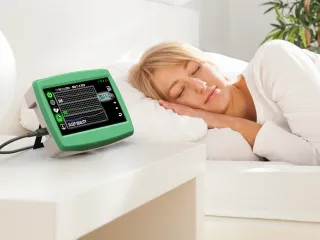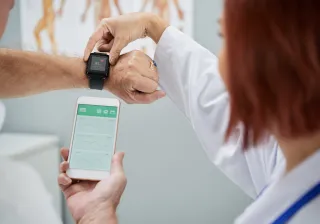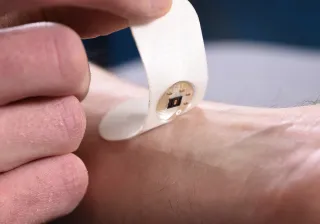VTT and eLive Ecosystem, a Finland-based health technology start-up have developed a new solution for monitoring vital functions during sleep. The sleep sensor designed for home use is placed underneath a mattress pad. It is easy to use and inconspicuous, but the diagnostic precision of the device enables the effective identification of sleep apnoea and the monitoring of treatment.
Key facts
At-home monitoring makes it possible to easily and reliably identify the symptoms of sleep apnoea.
The reliability and precision of the measurement technology mean that the results can be used to help select the right treatment and monitor progress.
The easy-to-use solution allows users to participate in looking after their own health and well-being.
eLive Ecosystem is certainly not short on ambition. Founded in 2016, the company develops technology that can be used for preventative monitoring of health at home, and for supporting treatment. The purpose of digital solutions that are easy to use is to build a comprehensive ecosystem, which makes it possible to prevent long-term illnesses and the damage that they cause without the need to significantly increase health care resources.
Sleep monitoring is demanding for measurement technology, but offers valuable analysis
The first product in the eLive ecosystem to prepare for a market entry is a device developed for identifying and monitoring sleep apnoea. VTT has served as eLive’s technology partner in its implementation. The sensor is placed under the mattress pad. It collects data from several measurement points, analysing the breathing, pulse, and level of activity of the sleeper, identifying the symptoms of sleep apnoea from the measurement data. Through multichannel measurements, the precision of the device has been brought close to that of traditional sleep laboratory studies. VTT has long worked to achieve reliable measurements and analysis.
“We had worked with technology linked with identifying sleep apnoea already before we began our collaboration with eLive. Research has been conducted together with leading researchers and hospitals in Europe, resulting in plenty of valuable data and scientific publications”, says Juha M. Kortelainen, Senior Scientist at VTT.
When the collaboration with eLive began, the first thing on the agenda was to refine skills and knowledge toward a consumer product. Calculation methods that had been validated as part of VTT's prior research, were made part of the product itself through a user device with a touch screen for collecting the data and for calculating and reporting the results.
“Sleep can be measured in many ways, and there are many kinds of devices on the market. However, comparable devices for screening of apnoea have not yet been approved as medical devices. The reliability and validation of the solution are crucial. In connection with previous research, we were able to demonstrate the performance of our solution in the measurement of both the heartbeat and respiration”, Kortelainen observes.
A central – and at the same time the most challenging issue – is to achieve good diagnostic precision in the solution, which is also easy and effortless for the user, without interfering with everyday life or sleep.
Sleep apnoea is a common, but underdiagnosed illness
Sleep apnoea is a common illness, and it is often latent. Of the nearly one billion people, who suffer from sleep apnoea only ten percent are getting treatment for it. With sufficiently precise measurement technology, the signs of the disease can be identified at an early stage.
“Sleep apnoea is a long-term illness that affects the quality of everyday life. It is often left undiagnosed, or it is identified only after it has already weakened a person's health. The shortfall in diagnosis leads to a shortfall in treatment. If the condition remains undiagnosed for a long time, sleep apnoea can lead to ancillary diseases such as type-2 diabetes, hypertension, and increase the risk of heart attacks and strokes”, says eLive CEO Mikko Saajanlehto.
The device itself is easy to use but developing it has required a unique combination of advanced measurement technology and tailored knowledge of algorithms. The device identifies breathing difficulties, reports deviations, and guides the patient to seek treatment, if necessary.
“A key issue – and the most challenging one – is to achieve a high degree of diagnostic precision in a solution that is easy and effortless also for the user, and does not interfere with everyday life or sleep. A low threshold for use is one of the things that have brought us positive feedback from doctors, among others”, Saajanlehto says.
The product developed together by eLive and VTT is exceptional by virtue of its applicability for independent use at home, and the resulting possibility for constant, or regular monitoring.
Strong evidence and a sense of achievement
When eLive was searching for a partner in technological development, it set some strict conditions. “It is often reality in the start-up world that there is no room or resources for failure. Consequently, we needed a partner with whom we could be certain to achieve good results. VTT has a good international reputation, strong evidence of its capabilities, and an extensive background in different kinds of health technology projects”, Saajanlehto says, describing the launch of the collaboration.
When a research centre was selected as a partner, it was self-evident that the studies would be carried out according to scientific standards, and in a way that would also suffice for the documentation of a quality system.
“When we were first planning the cooperation, we were warned that working with a research institute might be awkward for a start-up. However, work has proceeded efficiently; cooperation has been excellent and communications with the core team has been seamless. We have all had the same starting point. Things need to be based on research and evidence.”
The reality of the start-up world is often such that there is no room or resources for failure. Therefore, we needed a partner with whom we could be sure to get good results.
Aiming at a comprehensive digital tool kit for proactive health care
A huge amount of latent potential remains in digital solutions in the prevention and monitoring of long-term illnesses. When advanced measurement and sensor technologies and machine learning are harnessed for use in the monitoring of health, it is possible to create the means to evaluate the risk of illness reliably and individually. The device for measuring sleep apnoea is only the beginning for eLive, and the ecosystem is set to expand further. Meanwhile, collaboration between VTT and eLive will continue.







